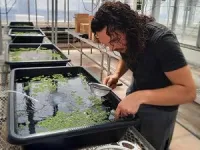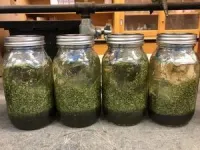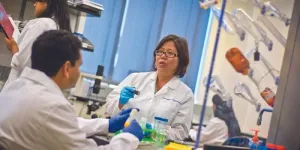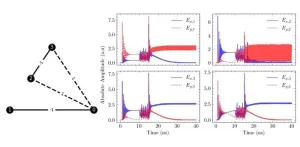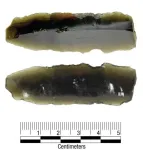(Press-News.org) UNIVERSITY PARK, Pa. — An often-overlooked water plant that can double its biomass in two days, capture nitrogen from the air — making it a valuable green fertilizer — and be fed to poultry and livestock could serve as life-saving food for humans in the event of a catastrophe or disaster, a new study led by Penn State researchers suggests.
Native to the eastern U.S., the plant, azolla caroliniana Willd — commonly known as Carolina azolla — also could ease food insecurity in the near future, according to findings recently published in Food Science & Nutrition. The researchers found that the Carolina strain of azolla is more digestible and nutritious for humans than azolla varieties that grow in the wild and also are cultivated in Asia and Africa for livestock feed.
The study, which was led by Daniel Winstead, a research assistant in the labs of Michael Jacobson, professor of ecosystem science and management, and Francesco Di Gioia, assistant professor of vegetable crop science, is part of a larger interdisciplinary research project called Food Resilience in the Face of Catastrophic Global Events conducted in the College of Agricultural Sciences.
“Other species of azolla have been used across the world for several thousand years as a livestock feed and as ‘green manure’ to fertilize crops because of the plant’s ability to fix nitrogen,” Jacobson said. “The use of azolla for human consumption was thought to be limited by its high total polyphenolic content, which interferes with its digestibility. But this research demonstrates that the phenolic content of the Carolina strain is much lower, and cooking the plant diminishes it further.”
Polyphenols, which are naturally abundant compounds found in plants, at lower concentrations are beneficial to human health because of their antioxidant activity, however, high concentrations of polyphenols can limit nutrient absorption in the body and act as antinutritional factors, Jacobson explained. Gallic acid is a stable phenol and has become a standard measurement to determine phenol content in food.
In the study, Carolina azolla — which has been described as having a crisp texture and a neutral taste — was grown in a greenhouse located at Penn State's University Park campus. The researchers determined that Carolina azolla has a total phenolic content of about 4.26 grams, gallic acid equivalents per kilogram dry weight.
This measurement compares with fruits, Winstead pointed out, which generally are between 1.4 and 6.2; beans at 1.2 to 6.6; and nuts, ranging from 0.5 to 19. By comparison, he added, other species of azolla that grow in Asia and Africa are between 20 and 69 grams, gallic acid equivalents per kilogram dry weight — too high for humans to digest comfortably.
The researchers tested three cooking methods — boiling, pressure cooking and natural fermentation — that multiple studies have shown can decrease polyphenolic content in foods, with the aim of reducing antinutritional factors potentially restricting consumption of azolla by both humans and livestock. Tests showed total phenol content was reduced by 88%, 92% and 62% with boiling, pressure cooking and natural fermentation, respectively, compared to the raw plant.
Carolina azolla — sometimes referred to as mosquito fern, fairy moss and water fern — holds excellent potential for use as a fast-growing, short-season crop that requires minimal inputs, upkeep and processing, Winstead noted, adding that the plant could be used to increase the food supply.
“Our study highlights the nutritional value and moderate protein content of Carolina azolla and demonstrates that cooking methods easily and significantly reduce total phenolic content,” he said. “Azolla’s moderate protein and high mineral yields make this species desirable for cultivation.”
The easy, fast-growing nature of azolla cultivation makes it an ideal resource during disasters and catastrophes, as well as for regular use by smallholder farms and low-income areas, the researchers said. It is a multipurpose wild edible plant that holds great potential for economic, agricultural, nutritional and resiliency benefits, but needs further development, they said.
“Whether it be for a ‘quick-fix’ solution in catastrophe scenarios or long-term resilience plan, Carolina azolla has the potential to provide large amounts of protein and calories for people and livestock,” he said, noting that the plant has even been considered for inclusion in the U.S. space program. “If systems for azolla cultivation and preparation can be made more efficient, its indoor or outdoor cultivation after natural disasters could provide supplemental nutrient production that are climate resilient.”
This study links to other ongoing systematic reviews by the same Penn State researchers examining regional, resilient, drought-resistant food crops and increased agrobiodiversity in the face of disasters becoming more frequent and often resulting in food-system disruptions. For example, one paper published in Frontiers in Sustainable Food Systems, looks at the plethora of currently seldom-used wild edible plants of North America that once were used abundantly by Native Americans.
“Currently, we are doing reviews in African regions,” Jacobson said. “Hopefully, exposing the viability of the lesser-used plants can help society be more prepared to secure a resilient food system.”
Marjorie Jauregui, doctoral degree student in food science and international agriculture, contributed to this research.
This research was funded by the Food Resilience in the Face of Catastrophic Global Events grant funded by Open Philanthropy and was supported by the U.S. Department of Agriculture’s National Institute of Food and Agriculture.
END
Common plant could help reduce food insecurity, researchers find
Fast-growing aquatic fern has the nutritional content to serve as a potentially vital food source after a catastrophe and could be relevant now
2024-02-23
ELSE PRESS RELEASES FROM THIS DATE:
Innovative chemotherapy approach shows promise against lung cancer
2024-02-23
Lung cancer is not the most common form of cancer, but it is by far the deadliest.
Despite treatments such as surgery, radiation therapy and chemotherapy, only about a quarter of all people with the disease will live more than five years after diagnosis, and lung cancer kills more than 1.8 million people worldwide each year, according to the World Health Organization.
To improve the odds for patients with lung cancer, researchers from The University of Texas at Arlington and UT Southwestern Medical Center have pioneered a novel approach to deliver cancer-killing drugs directly into cancer cells.
“Our method ...
Encoding computers of the future
2024-02-23
In our data-driven era, solving complex problems efficiently is crucial. However, traditional computers often struggle with this task when dealing with a large number of interacting variables, leading to inefficiencies such as the von Neumann bottleneck. A new type of collective state computing has emerged to address this issue by mapping these optimization problems onto something called the Ising problem in magnetism.
Here's how it works: Imagine representing a problem as a graph, where nodes are connected by edges. Each node has two states, either +1 ...
Artifact could be linked to Spanish explorer Coronado's expedition across Texas Panhandle
2024-02-23
DALLAS (SMU) – It’s a small piece of obsidian, just over 5 centimeters long, likely found on a hard-scrabble piece of ranchland in the Texas panhandle. But when SMU anthropologist Matthew Boulanger looks at it, he gets a mental image of Spanish explorer Francisco Vasquez de Coronado making his way across the plains more than 470 years ago in search of a fabled city of gold.
Boulanger believes that the flaked-stone tool with its sharp edge was likely dropped by a member of Coronado’s ...
Do’s and don'ts with direct oral anticoagulants
2024-02-23
Direct oral anticoagulants (DOACs) are a common treatment for patients with a wide variety of cardiovascular conditions. DOACs are the preferred treatment over vitamin K antagonists (VKAs) for many patients with atrial fibrillation or venous thromboembolism, since the latter would have a higher risk of intracranial bleeding and more complex dosing routine. However, new research suggests that DOACs should not be the first line of treatment for every patient who need to treat or prevent blood clots. A systematic overview from researchers at Brigham and Women’s Hospital, a founding member of Mass General Brigham, discusses the efficacy ...
Super strong magnetic fields leave imprint on nuclear matter
2024-02-23
UPTON, NY—A new analysis by the STAR collaboration at the Relativistic Heavy Ion Collider (RHIC), a particle collider at the U.S. Department of Energy’s (DOE) Brookhaven National Laboratory, provides the first direct evidence of the imprint left by what may be the universe’s most powerful magnetic fields on “deconfined” nuclear matter. The evidence comes from measuring the way differently charged particles separate when emerging from collisions of atomic nuclei at this DOE Office of Science user ...
TMEM208 variants cause a new developmental disorder
2024-02-23
A recent study conducted in the lab of Dr. Hugo J. Bellen, distinguished service professor at Baylor College of Medicine and principal investigator at the Jan and Dan Duncan Neurological Research Institute at Texas Children’s Hospital, has discovered a biological role of a specific transmembrane protein called TMEM208.
The study, published in the Proceedings of the National Academy of Sciences, showed that a majority of fruit flies lacking this gene do not survive, and the few that do survive have many developmental defects. Similarly, a child with variants ...
Researchers explore whether gut microbes cause some COVID-19 patients to have higher blood clot risk
2024-02-23
A gut microbial metabolite called 2-methylbutyrylcarnitine (2MBC) plays a role in exacerbating thrombosis -- the formation of blood clots – researchers report February 23rd in the journal Cell Metabolism. The results also revealed that 2MBC is accumulated in individuals with COVID-19, potentially explaining why these patients are at increased risk of thrombosis.
“Our study provides mechanistic insight by implicating 2MBC as a metabolite that links gut microbiota dysbiosis to elevated thrombotic ...
Childhood factors associated with unnatural death through midadulthood
2024-02-23
About The Study: In this urban population-based cohort study of 2,180 participants, no modifiable risk factors of mortality at the level of the individual (e.g., depression or anxiety and substance use) or the family (e.g., household education level) were identified. However, the degree of neighborhood poverty in early childhood was significantly associated with death by unnatural causes (death due to unintentional injury, suicide, and homicide) in early adulthood, suggesting that economic policies are needed to advance health equity in relation to premature mortality.
Authors: Holly C. Wilcox, Ph.D., of the Johns Hopkins Bloomberg ...
Severe COVID-19 in vaccinated adults with hematologic cancers in the Veterans Health Administration
2024-02-23
About The Study: In this case-control study including 6,122 patients with hematologic cancers and SARS-CoV-2 infection, odds of severe COVID-19 remained high through mid-2022 despite vaccination, especially in patients requiring treatment.
Authors: Paul A. Monach, M.D., Ph.D., of the VA Boston Cooperative Studies Program in Boston, is the corresponding author.
To access the embargoed study: Visit our For The Media website at this link https://media.jamanetwork.com/
(doi:10.1001/jamanetworkopen.2024.0288)
Editor’s Note: Please see the article for additional information, including other authors, author contributions ...
Recreational marijuana legalization and workplace injuries among younger workers
2024-02-23
About The Study: In this study, recreational marijuana laws that allow recreational marijuana sales were associated with a 10% increase in workplace injuries among individuals ages 20 to 34. The findings are consistent with the hypothesis that recreational marijuana impedes cognitive function and care among younger workers.
Authors: Joseph J. Sabia, Ph.D., of San Diego State University, is the corresponding author.
To access the embargoed study: Visit our For The Media website at this ...
LAST 30 PRESS RELEASES:
Norbert Holtkamp appointed director of Fermi National Accelerator Laboratory
New agentic AI platform accelerates advanced optics design
Biologists discover neurons use physical signals — not electricity — to stabilize communication
Researchers discover that a hormone can access the brain by hitchhiking
University of Oklahoma researcher awarded funding to pursue AI-powered material design
Exploring how the visual system recovers following injury
Support for parents with infants at pediatric check-ups leads to better reading and math skills in elementary school
Kids’ behavioral health is a growing share of family health costs
Day & night: Cancer disrupts the brain’s natural rhythm
COVID-19 vaccination significantly reduces risk to pregnant women and baby
The role of vaccination in maternal and perinatal outcomes associated with COVID-19 in pregnancy
Mayo Clinic smartwatch system helps parents shorten and defuse children's severe tantrums early
Behavioral health spending spikes to 40% of all children’s health expenditures, nearly doubling in a decade
Digital cognitive behavioral treatment for generalized anxiety disorder
Expenditures for pediatric behavioral health care over time and estimated family financial burden
Air conditioning in nursing homes and mortality during extreme heat
The Alps to lose a record number of glaciers in the next decade
What makes a good proton conductor?
New science reporting guide published for journalists in Bulgaria
New international study reveals major survival gaps among children with cancer
New science reporting guide published for journalists in Turkey
Scientists develop a smarter mRNA therapy that knows which cells to target
Neuroanatomy-informed brain–machine hybrid intelligence for robust acoustic target detection
Eight SwRI hydrogen projects funded by ENERGYWERX
The Lundquist Institute and its start-up company Vitalex Biosciences Announces Strategic Advancement of Second-Generation fungal Vaccine VXV-01 through Phase 1 Trials under $40 Million Competitive Con
Fine particles in pollution are associated with early signs of autoimmune disease
Review article | Towards a Global Ground-Based Earth Observatory (GGBEO): Leveraging existing systems and networks
Penn and UMich create world’s smallest programmable, autonomous robots
Cleveland researchers launch first major study to address ‘hidden performance killer’ in athletes
To connect across politics, try saying what you oppose
[Press-News.org] Common plant could help reduce food insecurity, researchers findFast-growing aquatic fern has the nutritional content to serve as a potentially vital food source after a catastrophe and could be relevant now

